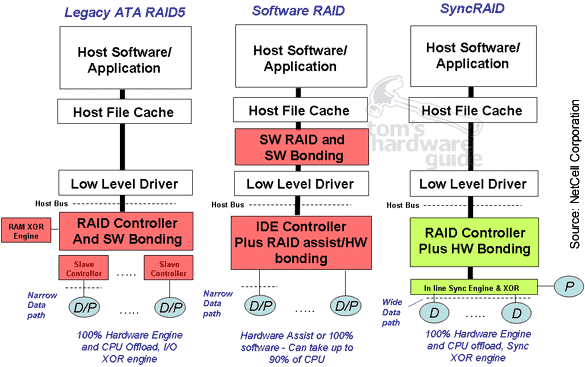Kill SCSI II: NetCell's RAID 0 Performance + RAID 5 Security Equals SyncRAID
Comparison With Previous Technologies
As can be seen clearly from the illustration above, the previously available bottlenecks (red) should be removed (green). They are necessary for all available RAID technologies, even though they are intended more as descriptions than as assessments.
Most RAID solutions (in the drawing to the left) trust in appropriate hardware whose job it is to control all hard drives. Professional variants use a hardware XOR unit to do the parity calculation mentioned above as quickly as possible. But that, too, still takes a lot of time, as shown clearly in performance comparisons between RAID 0 (striping) and RAID 5 (striping with parity) with the same number of hard drives. However, how terrible this really is must be distinguished from one case to the next, because in real-life applications, for example, one server has even more to do besides saving and calling up data.
Another variation is an approach based on a software layer. This includes the integrated ATA RAID controllers from Intel and VIA. The disadvantage of this is clear: the system processor has to take care of most operations itself. The result is a higher CPU load. Frankly, this is not tragic in all applications, because today's processors often provide sufficient reserves.
As already mentioned, the NetCell technology called SyncRAID writes broader data words to all hard drives. It should be possible to do the associated XOR calculation for the RAID XL / RAID 3 on which it is based in real time, as parity only needs to be generated for a data word instead of for several data blocks.
Get Tom's Hardware's best news and in-depth reviews, straight to your inbox.
Current page: Comparison With Previous Technologies
Prev Page NetCell 6405: The SyncRAID Architecture In Detail Next Page NetCell TurboDisk NC5464 In Practice
Patrick Schmid was the editor-in-chief for Tom's Hardware from 2005 to 2006. He wrote numerous articles on a wide range of hardware topics, including storage, CPUs, and system builds.
